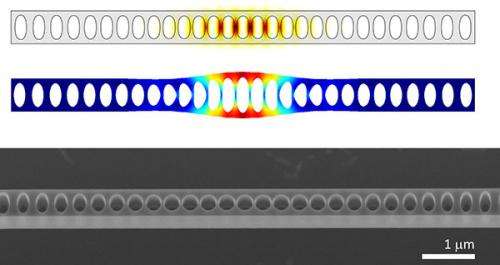Electromagnetically induced transparency in a silicon nitride optomechanical crystal

Researchers from the NIST Center for Nanoscale Science and Technology (CNST) have observed electromagnetically induced transparency at room temperature and atmospheric pressure in a silicon nitride optomechanical system. This work highlights the potential of silicon nitride as a material for producing integrated devices in which mechanical vibrations can be used to manipulate and modify optical signals. The ability to harness the radiation-pressure-based interaction between light and mechanical vibrations in these devices could lead to applications in optical communications and information processing such as optical wavelength conversion and optical signal storage.
Using the electron beam lithography system and reactive ion etcher available to users at the CNST NanoFab, the researchers produced a line of oval holes with dimensions of a few hundred nanometers on a 700 nm wide, 350 nm thick suspended silicon nitride beam. The finished structure is called a nanobeam optomechanical crystal, and is designed to have complementary mechanical and optical properties.
When near-infrared laser light is injected into the optomechanical crystal, it becomes confined within the etched, suspended beam, within a micrometer-scale region halfway along its length. The sidewalls of the optical confinement region mechanically expand and contract, vibrating at microwave frequencies, forming a so-called breathing mechanical mode. Energy from this breathing mode is added to the stored light, resulting in the generation of a new light signal with a slightly different color (called the anti-Stokes wavelength). This new light signal is also confined within the nanobeam. If an additional probe laser light, now at the anti-Stokes wavelength, is also injected into the crystal, it interferes with the generated optical signal. This interference causes the optomechanical crystal, which originally reflects back light at the anti-Stokes wavelength, to become transparent at that color. This phenomenon, called electromagnetically induced transparency (EIT), has recently been observed in a handful of cavity optomechanical systems at telecom and visible wavelengths. For the first time, the researchers demonstrated the phenomenon at a near-infrared wavelength with the system operating at room temperature and atmospheric pressure and using only moderate optical power.
This result was made possible by designing the system to use radiation pressure to achieve a strong interaction between the stored light and mechanical vibrations of the nanobeam, and by fabricating the device from silicon nitride, a common material in chip-scale devices which is optically transparent over a broad range of wavelengths.
The device demonstrates that optics and mechanics can interact within the silicon nitride platform. It is a first step towards applications that leverage this interaction, including wavelength conversion in which widely spaced optical wavelengths are connected through interaction with the mechanical system. Future work will focus on such wavelength conversion, connecting near-infrared wavelengths planned for quantum information applications, infrared wavelengths used for telecommunications, and possibly even microwave frequencies used in superconducting quantum circuits.
The NIST Center for Nanoscale Science and Technology (CNST) is a national nanotechnology user facility that enables innovation by providing rapid access to the tools needed to make and measure nanostructures. Researchers interested in accessing the techniques described here or in collaborating on their future development should contact Marcelo Davanço. The team included researchers from the CNST, the University of Maryland, and the California Institute of Technology.
More information: "Si3N4 optomechanical crystals in the resolved-sideband regime," M. Davanço, S. Ates, Y. Liu, and K. Srinivasan, Applied Physics Letters 104, 041101 (2014).
Journal information: Applied Physics Letters
Provided by National Institute of Standards and Technology




















